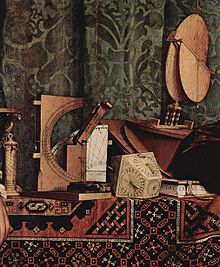Torquetum

A torquetum or turquetum (lat. Torquetum , turquetum , turketum and other word variants, also as a masculine with -us , English and French turquet ) is an astronomical instrument that combines the functions of an armillary sphere and an astrolab and enables the coordinates of a celestial body as well as its current altitude and time after unequal hours .
Bulk
The origin of the name is not certain. It is usually derived from the Latin torqueri "turn, twist", but was evidently associated with turcus "Turkish" as early as the Middle Ages . The origin of the instrument is also unknown. It is possibly an Arab invention and is often given specifically as the invention of Gabir ibn Aflah (Geber), who described two instruments in the first half of the 12th century, but which can at best be regarded as precursors.
The oldest descriptions can be found in two Latin texts. On the one hand, there is a Tractatus de torqueto , handed down in numerous manuscripts , the writing of which or the oldest dated copy was completed on July 2, 1284 in Paris. Said in the manuscripts author, Franco de Polonia is otherwise unknown, his occasionally contemplated identity with the teaching at that time also in Paris German music theorist Franco of Cologne ( "Franco de C olonia") is not assured. A further description of the Torquetum can be found in the Tractatus super totam astrologiam by the Franciscan and Professor Bernhard von Verdun (Bernardus de Virduno), who also did not emerge from other writings , whose writing cannot be dated with certainty, but at least not before 1264 and probably not after 1320 originated.
Further evidence for knowledge and use of the instrument emerges from comet observations from 1299 by Petrus von Limoges (Petrus Lemovicensis) and from 1301 (anonymous, possibly also by Petrus von Limoges). Also Johannes de Muris used the instrument for measurement on March 12, 1318. Full tracts were later by John of Gmunden († 1442) or one of his students and Johannes Johannes Regiomontanus and Peter Apian written (1532).
The oldest illustrations can be found in a manuscript from the mid-14th century in the Ashmolean Library in Oxford. The oldest surviving instruments come from the possession of Marcin Bylica (made by Hans Dorn ) and Nikolaus von Kues . The latter had bought the instrument in Nuremberg. According to Hartmann's studies published in the Zeitschrift für Instrumentenkunde in December 1920, the Turkish device was built by Cusanus around the year 1434.
A representation of the instrument that is also significant in terms of art history can be found in the painting “ The French Ambassadors ” by Hans Holbein the Younger .
Individual evidence
- ↑ Doris Wolfangel: Dr. Melchior Ayrer (1520-1579). Medical dissertation Würzburg 1957, p. 36 and more.
- ↑ Ralf Kern: Scientific instruments in their time / volume 1. Verlag Walther König, Cologne 2010. P. 226.
literature
- Wolf Frobenius: The music theorist Franco of Cologne. In: Albert Zimmermann (ed.): The Cologne University in the Middle Ages: spiritual roots and social reality. de Gruyter, Berlin, New York 1989, ISBN 3-11-012148-4 , pp. 345-356 (= Miscellanea Mediaevalia, 20).
- Richard Lorch: Turquetum. In: Lexicon of the Middle Ages. Volume VIII. 1997, Col. 1120.
- Emmanuel Poulle : Bernard de Verdun et le turquet. In: Isis. 55, 2, 1964, pp. 200-208.
- Lynn Thorndike : Franco de Polonia and the Turquet. In: Isis. 36, 1, 1945/1946, pp. 6-7.
- Ernst Zinner : German and Dutch astronomical instruments of the 11th to 18th centuries. Beck, Munich 1956.
Web links
- Richard A. Paselk: The Torquetum (English)
